The Everest Base Camp is not just a journey through some of the world’s most breathtaking landscapes, but also an experience enriched with cultural insights and personal triumph. Choosing the best month for trekking in the Everest Region is crucial to fully appreciate the majestic beauty of this area and make the most of your adventure. Factors such as weather conditions, temperature range, crowd levels, and Everest region trekking climate play a significant role in determining the right time for this trek. Luxury Holidays Nepal, with its deep understanding and extensive experience in Himalayan treks, provides an insightful guide to help you decide the optimal time for this once-in-a-lifetime journey. Whether you're contemplating the vibrant, lively trails of the spring, the serene and clear autumn paths, or the unique and less-traveled routes of winter and summer, understanding the dynamics of each month is key to a successful and memorable Everest expedition.
We take immense pride in being recognized as the leading choice for adventurers eager to embark on an unforgettable journey to Everest Base Camp. Our deep understanding of the best month for trekking in the Everest Region, combined with unparalleled expertise and personalized services, sets us apart. We meticulously tailor each expedition to align with the optimal trekking conditions, ensuring our clients experience the majestic beauty of the Everest region in the best possible light. From providing detailed insights into the Everest trekking season guide, advising on the weather conditions and temperature range, to expertly navigating through varying crowd levels, our team is dedicated to ensuring a safe, memorable, and enriching journey. Whether you’re an experienced trekker or a first-time adventurer, Luxury Holidays Nepal is your trusted partner, committed to delivering an exceptional trekking experience that aligns seamlessly with the best seasons of the Everest region. Choose us to discover why we are regarded as the best in guiding trekkers through this magnificent part of the Himalayas.
Weather Conditions and Climate
When discussing the best month for trekking in the Everest Region, a key factor to consider is the weather conditions and climate. The Everest region, known for its dramatic changes in weather and varying climates at different altitudes, can greatly impact the trekking experience. Understanding these nuances is vital for a successful and enjoyable trek.
Spring (March to May)
- Climate: During spring, the weather is generally stable and dry, with warmer days and cooler nights.
- Temperature: Daytime temperatures can range from 15°C to 20°C at lower altitudes, while nights may drop to -1°C or lower as you gain altitude.
- Visibility: This season offers excellent visibility, making it ideal for breathtaking views of Mount Everest and the surrounding peaks.
- Overall Conditions: Spring is the time for clear blue skies, blooming rhododendrons, and relatively comfortable trekking conditions.
Autumn (September to November)
- Climate: Similar to spring, autumn is characterized by stable weather with little to no rain. It is a post-monsoon period where the air is clean and fresh.
- Temperature: Daytime temperatures are pleasant, ranging between 15°C to 20°C at lower elevations. Night temperatures can drop below freezing as you ascend.
- Visibility: Known for its crystal-clear skies, autumn offers some of the best mountain views, making it a popular choice for trekkers.
- Overall Conditions: The trails are dry and stable, providing comfortable trekking conditions.
Summer (June to August)
- Climate: Coinciding with the monsoon season, summer brings wetter conditions with frequent rain showers, especially in the afternoons.
- Temperature: Warmer and more humid, with temperatures ranging from 20°C to 25°C at lower altitudes.
- Visibility: Cloudier skies and occasional rain can obscure mountain views, but the landscape is lush and vibrant.
- Overall Conditions: Trails can be slippery and leech-prone, but the region is less crowded, offering a unique trekking experience.
Winter (December to February)
- Climate: Winter in the Everest region is cold and dry. Snowfall at higher altitudes is common.
- Temperature: Daytime temperatures can be bearable, but night temperatures often plunge below freezing, especially at higher altitudes.
- Visibility: Skies are usually clear, offering great views, but the cold can be challenging.
- Overall Conditions: The trails are less crowded, but some high passes may be closed due to snow.
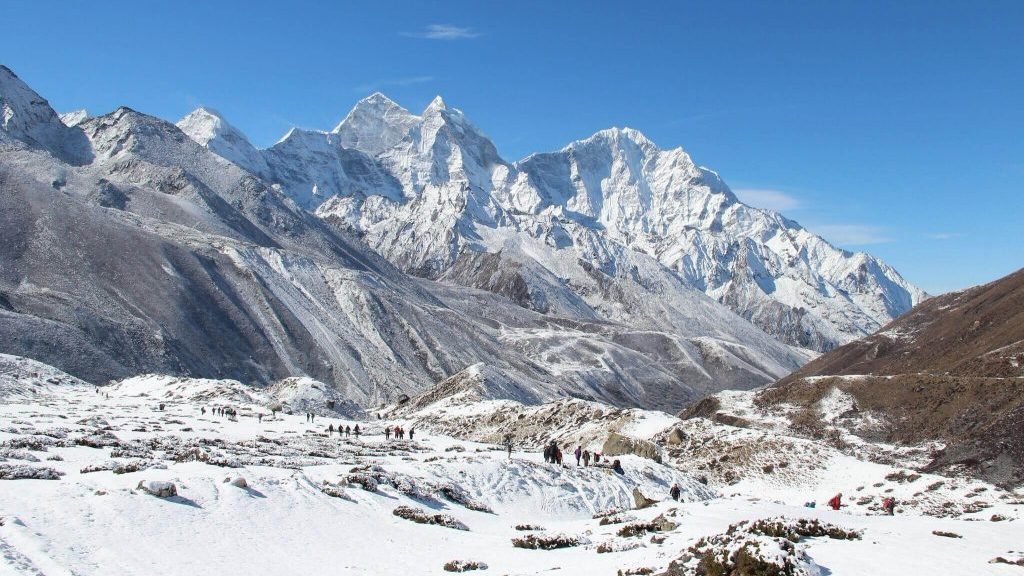
The Everest Base Camp's best season largely depends on what you value most: stable weather, clear skies, or avoiding crowds. Spring and autumn are the peak trekking seasons due to their favorable weather conditions and climate, making them the most recommended times for an Everest trek. However, some adventurers may prefer the solitude of winter or the lush landscape of summer. Luxury Holidays Nepal can help you navigate these choices, ensuring a safe and remarkable journey regardless of the season you choose.
Visibility and Scenery
When it comes to trekking in the Everest Region, visibility and scenery are crucial elements that can dramatically enhance the experience. Different months offer varying visual spectacles, making the choice of the best month to trek not just about weather conditions, but also about the kind of scenic beauty you wish to experience.
Spring (March to May)
- Visibility: Exceptional. This period is known for its clear blue skies, providing trekkers with uninterrupted views of Mount Everest and other Himalayan giants.
- Scenery: Spring is vibrant, marked by blooming rhododendrons and other wildflowers, particularly at lower altitudes. The forests and hills burst into a riot of colors, offering a stark contrast against the snow-capped peaks.
- Highlights: It's also a great time for photography enthusiasts, as the lighting conditions and the colorful landscapes provide perfect photo opportunities.
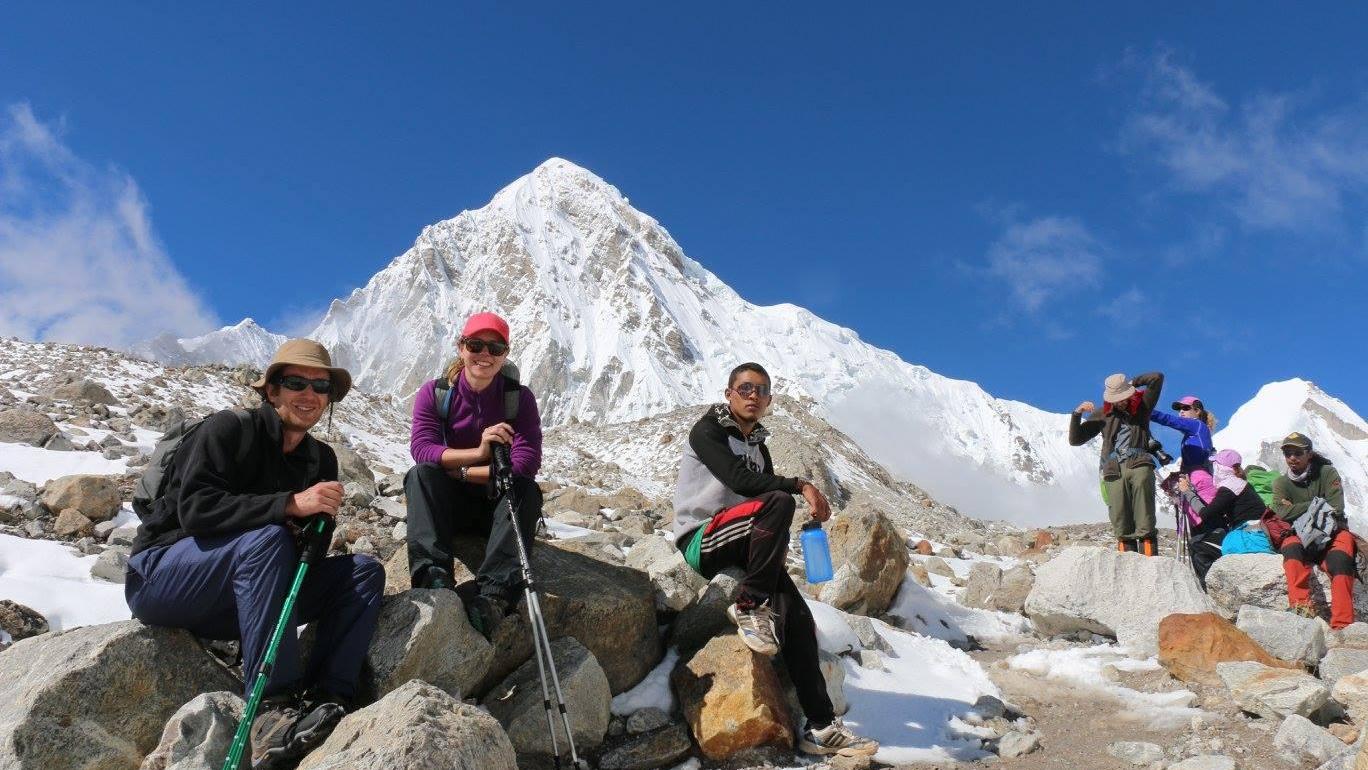
Autumn (September to November)
- Visibility: Comparable to spring, autumn offers crystal-clear skies with excellent visibility. The post-monsoon period leaves the atmosphere clean and dust-free, resulting in spectacular mountain views.
- Scenery: The landscape in autumn is characterized by golden hues and a more subdued green, with the terraced fields often harvested or in the process of harvest.
- Highlights: The clear, crisp days of autumn are perfect for trekkers who enjoy vivid mountain panoramas against a backdrop of deep blue skies.
Summer (June to August)
- Visibility: Summer, coinciding with the monsoon, tends to have cloudier skies, which can occasionally obscure mountain views. However, the moments when the clouds part can be dramatically beautiful.
- Scenery: This season brings lush greenery, with the forests and valleys at their most vibrant and waterfalls at their fullest.
- Highlights: Ideal for those who appreciate lush landscapes and are willing to endure occasional rain for the reward of spectacular, mist-shrouded vistas.
Winter (December to February)
- Visibility: The skies are usually very clear in winter, offering excellent visibility. The air is crisp and the visibility is often at its best, albeit with colder temperatures.
- Scenery: The landscape is stark but beautiful, with snow-covered peaks and often snow along the trail at higher altitudes.
- Highlights: Winter treks are for those who appreciate the serene beauty of the mountains and don’t mind the cold. The snowy landscape provides a unique and tranquil trekking experience.
For the best visibility and scenery, spring and autumn are the most favorable times to trek in the Everest Region. These seasons offer clear skies and distinct landscapes, ideal for trekkers seeking to experience the full majesty of the Himalayas. The lush greenery of summer and the serene snowscapes of winter also have their unique appeal. Luxury Holidays Nepal can guide you through these seasonal changes, ensuring an unforgettable experience tailored to your preferences.
Crowd Levels
When considering the best month for trekking in the Everest Region, understanding the crowd levels during different times of the year is an important aspect. The number of fellow trekkers on the trail can significantly impact your experience, from the atmosphere of the trek to the availability of accommodation in teahouses and lodges.
Spring (March to May)
- Crowd Levels: High. Spring, particularly April and early May, is one of the most popular times to trek in the Everest region.
- Atmosphere: The trails buzz with activity, and there's a vibrant, communal feel with trekkers from around the world converging on this iconic route.
- Consideration: While the sense of camaraderie can be enjoyable, those seeking solitude may find the trails too busy.
Autumn (September to November)
- Crowd Levels: Moderately High. Autumn is another peak season for Everest treks but is generally slightly less crowded than spring.
- Atmosphere: There's a balance between a lively trail experience and the chance to find quieter moments, especially as you move away from the more popular spots.
- Consideration: It's still important to book accommodations in advance, as popular spots can fill up quickly.
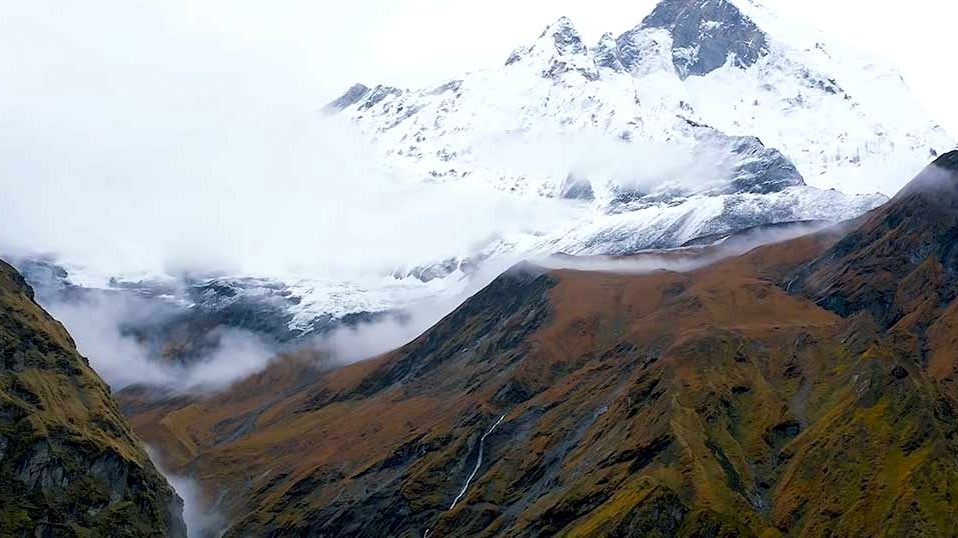
Summer (June to August)
- Crowd Levels: Low. This is the monsoon season, and many trekkers avoid this time due to the rain and potential visibility issues.
- Atmosphere: The trails are quieter, offering a more solitary trekking experience.
- Consideration: This season can be appealing for those who prefer solitude and don't mind the rain and slippery trails.
Winter (December to February)
- Crowd Levels: Very Low. Winter is the least popular season due to the cold weather and snow, especially at higher altitudes.
- Atmosphere: The trails are serene, and trekkers can enjoy a peaceful journey with minimal disturbances.
- Consideration: This season is ideal for those who appreciate solitude and are prepared for the cold and potential trail difficulties.
The choice of the best month for trekking in the Everest Region based on crowd levels depends largely on personal preferences. If you enjoy a bustling trail and meeting fellow adventurers, the spring and autumn seasons are ideal. However, for those seeking a more peaceful and solitary experience, the summer and winter months are preferable. At Luxury Holidays Nepal, we provide expert advice and planning to ensure your trek aligns with your crowd preference, ensuring an optimal and personalized trekking experience.
Temperature Range
When planning a trek in the Everest Region, understanding the temperature range during different times of the year is crucial for proper preparation and comfort. The region experiences significant variations in temperature, not only between seasons but also between day and night.
Spring (March to May)
- Daytime Temperatures: Generally mild, ranging from 15°C to 20°C at lower altitudes, providing a comfortable environment for trekking.
- Nighttime Temperatures: Can drop to around -1°C or lower, especially at higher altitudes. It's crucial to be prepared for colder nights.
- Consideration: Weather is generally stable, but it's important to be prepared for sudden changes.
Autumn (September to November)
- Daytime Temperatures: Similar to spring, daytime temperatures hover around 15°C to 20°C, offering pleasant trekking conditions.
- Nighttime Temperatures: Temperatures at night can fall below freezing as you ascend, especially towards the end of autumn.
- Consideration: Days are sunny and clear, but mornings and evenings can be brisk, so layered clothing is recommended.
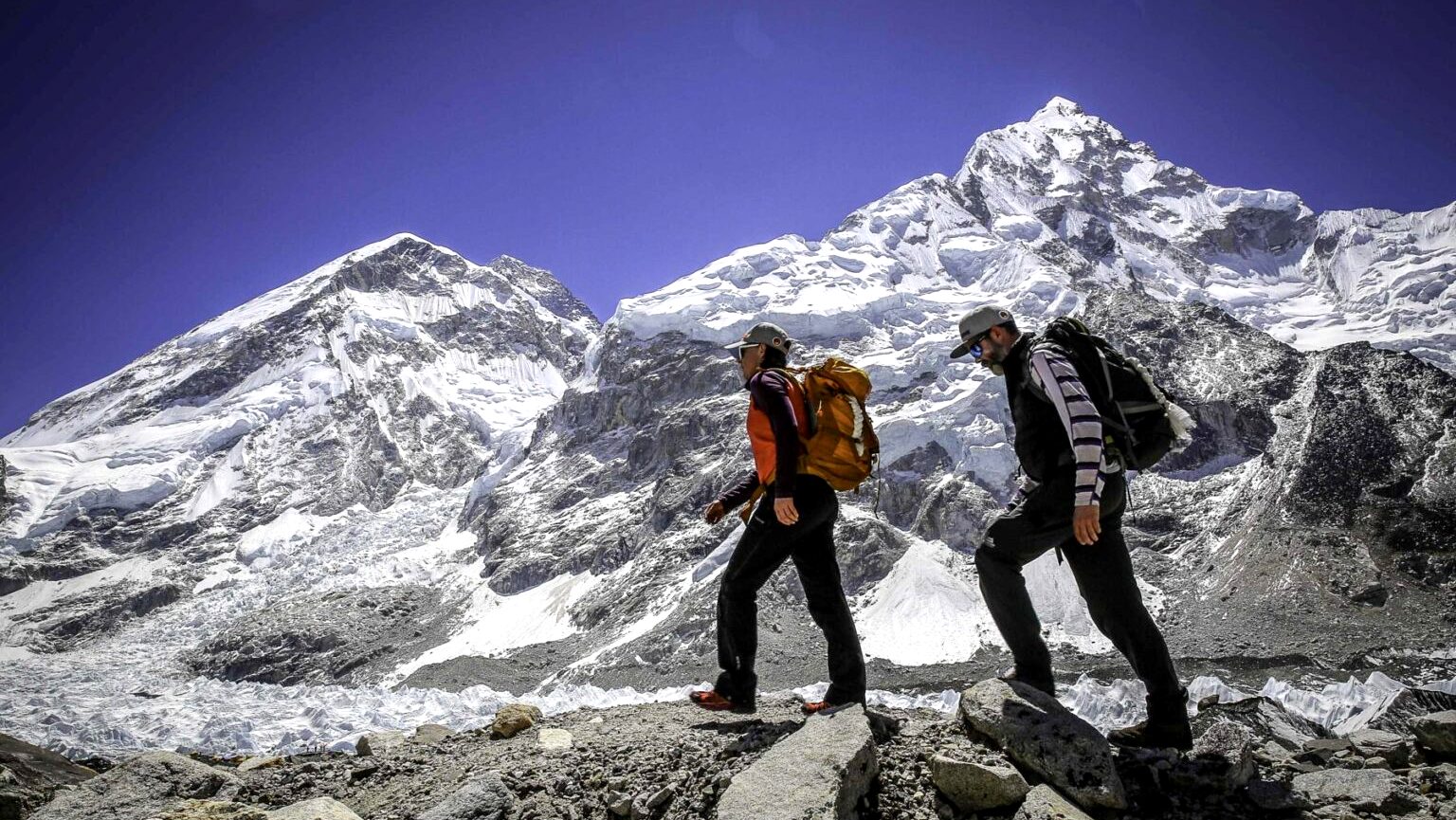
Summer (June to August)
- Daytime Temperatures: Warmer, ranging from 20°C to 25°C, making it slightly warmer compared to other seasons.
- Nighttime Temperatures: Remain mild but can be damp due to the monsoon rain.
- Consideration: The humidity level is higher, so it's essential to stay hydrated and protect against leeches and slippery trails.
Winter (December to February)
- Daytime Temperatures: Can be bearable and occasionally warm when the sun is out, but generally, it's cold with temperatures sometimes barely rising above freezing during the day.
- Nighttime Temperatures: Often plummet below -10°C, especially at higher elevations. It can be extremely cold during the night.
- Consideration: Proper winter gear is essential. Days can be sunny and clear, but the cold is a significant factor, particularly at night.
The temperature range greatly influences the trekking experience in the Everest Region. Spring and autumn offer the most comfortable range of temperatures for most trekkers, with warmer days and cooler, but not extremely cold, nights. Summer presents a warmer, wetter option, while winter offers a colder but quieter trekking experience. At Luxury Holidays Nepal, we advise trekkers on the appropriate gear and preparations for the expected temperatures, ensuring a safe and comfortable journey regardless of the season chosen.
Everest Trek Difficulty by Month
The difficulty of trekking in the Everest Region varies significantly by month, largely influenced by weather conditions and climate. Understanding these variations can help trekkers prepare adequately for their journey. Here's a breakdown of how trek difficulty shifts throughout the year:
Spring (March to May)
- Difficulty Level: Moderate. This is one of the best times for Everest treks, with favorable weather and trail conditions.
- Trail Conditions: Generally dry and stable. As the snow from winter melts, higher passes become accessible.
- Additional Factors: Increased foot traffic on popular trails may slow down progress, but the paths are generally in good condition.
Autumn (September to November)
- Difficulty Level: Moderate. Similar to spring, this season is ideal for trekking, with stable weather and clear skies.
- Trail Conditions: Trails are dry and firm, making for easier hiking. High passes are usually clear of snow.
- Additional Factors: Crowds can be a factor in trek difficulty, especially on the more popular routes.
Summer (June to August)
- Difficulty Level: Challenging. Monsoon season brings rain, slippery trails, and leeches, adding to the trek's difficulty.
- Trail Conditions: Muddy and slippery, especially in the lower regions. Visibility can also be an issue due to cloud cover and fog.
- Additional Factors: Fewer trekkers on the trails, but weather-related disruptions, like landslides or flight delays, can complicate the trek.
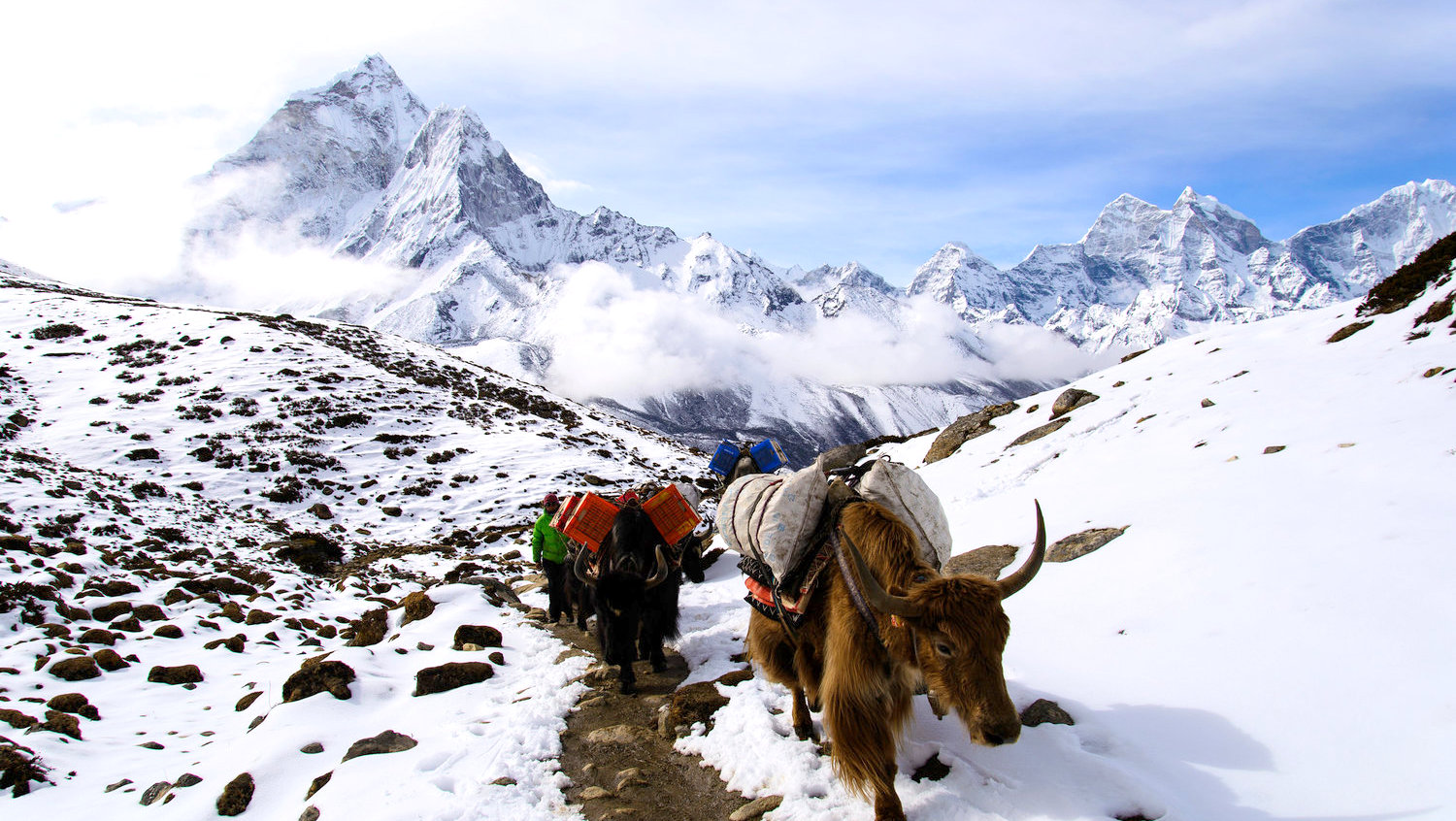
December
Winter (December to February)
- Difficulty Level: High. Cold weather and snow increase the trek's difficulty, especially at higher elevations.
- Trail Conditions: Snow and ice can make trails slippery. Some high passes may be closed due to heavy snowfall.
- Additional Factors: Shorter daylight hours limit trekking time. Extreme cold requires proper gear and precautions against frostbite and hypothermia.
The difficulty of trekking in the Everest Region varies greatly by month. Spring and autumn offer the most favorable conditions with moderate difficulty, while summer and winter present more challenging conditions due to weather and trail state. Luxury Holidays Nepal considers these factors in planning and providing support for trekkers, ensuring a safe and enjoyable experience tailored to the specific challenges of each season. Whether you're a seasoned trekker or a first-timer, understanding these monthly variations is key to a successful and fulfilling Everest trek.
Spring vs Autumn
Choosing between spring and autumn for trekking in the Everest Region can be a challenging decision, as both seasons are highly popular and offer distinct advantages. Here's a comparison to help understand the nuances of trekking during these two peak seasons:
Spring (March to May)
Advantages
- Vibrant Landscapes: Spring is a time of renewal in the Himalayas. The forests and lower valleys are alive with blooming rhododendrons and other wildflowers, creating a picturesque setting.
- Mild Weather: Temperatures are moderate, making daytime trekking more comfortable. The weather is generally stable, although there can be occasional showers.
- Peak Climbing Season: This is also the season for Everest expeditions, so the region has a buzzing atmosphere with climbers and trekkers.
Considerations
- Higher Crowds: As one of the peak seasons, the trails and teahouses tend to be more crowded.
- Slightly Unpredictable Weather: Despite generally stable weather, spring can occasionally have sudden weather shifts, including brief showers or snow at higher elevations.
Autumn (September to November)
Advantages
- Stable and Clear Weather: Post-monsoon, the skies clear up, offering some of the best mountain views. The weather is generally stable, with less risk of precipitation.
- Comfortable Temperature: Days are comfortably warm, and nights, while chilly, are not as cold as in late winter or early spring.
- Cultural Festivals: Autumn coincides with several Nepalese festivals, adding cultural richness to the trekking experience.
Considerations
- Crowds: While slightly less crowded than spring, autumn also sees a significant number of trekkers on the trails.
- Chilly Mornings and Evenings: As winter approaches, mornings and evenings can be quite cold, especially at higher altitudes.
Both spring and autumn offer excellent conditions for trekking in the Everest Region, with each season having its unique charm. Spring is characterized by vibrant landscapes and a lively atmosphere with climbers, while autumn provides stable weather and incredible clarity for mountain views. The choice ultimately depends on what you value more - the floral displays and dynamic environment of spring or the clear skies and cultural experiences of autumn. Luxury Holidays Nepal ensures a well-planned and fulfilling trekking experience, regardless of the season you choose, catering to your preferences and ensuring a memorable journey in the Everest Region.
Off-Peak Seasons (Summer and Winter)
Exploring the Everest Region during the off-peak seasons of summer and winter offers a unique perspective on this majestic landscape, different from the more popular trekking times in spring and autumn. Each of these seasons - summer (June to August) and winter (December to February) - has distinct characteristics that can appeal to certain types of trekkers.
Summer (June to August)
Characteristics
- Monsoon Season: This period coincides with the monsoon in Nepal, bringing frequent rains, especially in the afternoons and evenings.
- Lush Landscapes: The rain transforms the region into a verdant paradise, with full rivers, green valleys, and an abundance of flora.
- Lower Crowds: Fewer trekkers choose this season, offering a more solitary experience on the trails.
Considerations
- Trail Conditions: Trails can be slippery and muddy, requiring careful trekking. Leeches and mosquitoes are also more prevalent during this season.
- Views and Weather: Mountain views are often obscured by clouds and fog, but when they clear, the views can be spectacular and dramatic.
- Travel Delays: Flights to and from Lukla (the gateway to Everest) can be delayed or canceled due to weather conditions.
Winter (December to February)
Characteristics
- Cold Weather: Temperatures can drop significantly, especially at higher altitudes. Days can be sunny, but nights are often extremely cold.
- Clear Skies: The air is typically drier and clearer, offering some of the best mountain views, with snow-capped peaks in all their glory.
- Quiet Trails: With the least number of trekkers, the trails are peaceful, offering a more intimate experience of the Himalayas.
Considerations
- Challenging Conditions: Snow and ice can make certain parts of the trail more challenging, and some high passes may be closed.
- Winter Gear: Adequate cold-weather gear is essential, including insulated clothing, sleeping bags, and possibly even crampons for higher sections.
- Shorter Days: Daylight hours are limited, so trekkers need to plan their daily treks accordingly.
Trekking in the Everest Region during the off-peak seasons of summer and winter can be a rewarding experience for those who seek a different kind of adventure. Summer offers lush landscapes with fewer crowds but comes with the challenge of rain and cloudier skies. Winter presents a pristine and tranquil mountain environment with clear views, albeit with the challenges of cold temperatures and potential snow. Luxury Holidays Nepal provides expert guidance and support to ensure trekkers are well-prepared for these unique conditions, offering an unforgettable experience in the Everest Region during these less-trodden times.
Tourist Volume
The volume of tourists trekking in the Everest Region fluctuates significantly throughout the year, impacting the overall experience of the journey. Understanding these variations is crucial for planning your trek, whether you seek a bustling, social atmosphere or a more serene, solitary experience.
High Tourist Volume: Spring and Autumn
- Spring (March to May) and Autumn (September to November) are the peak seasons for trekking in the Everest Region. These months attract the highest number of tourists due to the favorable weather conditions and clear skies.
- Spring is particularly busy as it coincides with the mountaineering season, drawing not only trekkers but also mountaineers heading to Everest and other high peaks.
- Autumn, post-monsoon, offers clear skies and stable weather, making it ideal for trekking and thus attracting large numbers of tourists.
Moderate Tourist Volume: Winter and Summer
- Winter (December to February) sees a moderate number of tourists. The colder temperatures and snow at higher altitudes deter some trekkers, but the clear skies and quieter trails appeal to others.
- Summer (June to August), coinciding with the monsoon season, also experiences a moderate tourist volume. The rain and cloud cover, along with the challenging trail conditions, reduce the number of trekkers. However, some adventurers prefer this season for the lush landscapes and solitude it offers.
Low Tourist Volume: Shoulder Months
- The shoulder months - early spring (late February and early March) and late autumn (late November and early December) - generally see fewer tourists. These periods are transitions between the peak and off-peak seasons, offering a balance between decent trekking conditions and fewer crowds.
The tourist volume in the Everest Region is highest during the spring and autumn months, offering vibrant social experiences but also more crowded trails and teahouses. Winter and summer see fewer tourists, providing a quieter and more solitary trekking experience, albeit with more challenging weather and trail conditions. Luxury Holidays Nepal provides tailored itineraries and expert guidance to help you navigate these variations, ensuring an optimal trekking experience regardless of when you choose to embark on your Everest adventure.
Cultural Experiences
Trekking in the Everest Region is not only about the physical journey and the stunning landscapes but also about immersing oneself in the rich cultural experiences that the region offers. Each month brings its own unique cultural aspects, making the trek an enriching experience beyond just the hike.
Spring (March to May)
- Cultural Highlight: The Sherpa Culture is vibrant during this season. With the onset of the climbing season, there are numerous rituals and ceremonies, like the Puja Ceremony, performed for good luck before climbers ascend Everest.
- Festivals: Spring is also a time for some local festivals, like Buddha Jayanti, the birth anniversary of Lord Buddha, celebrated with much fervor in the monasteries.
Autumn (September to November)
- Cultural Highlight: Autumn is marked by the biggest Nepalese festivals - Dashain and Tihar. These festivals offer a deep insight into the local culture, traditions, and family values.
- Festive Atmosphere: Trekkers can experience how locals decorate their homes, enjoy special meals, and participate in traditional rituals.
Summer (June to August)
- Cultural Highlight: Summer is the time of monsoon which means fewer tourists and a chance to see the everyday life of the locals without the embellishments for tourism.
- Agricultural Activities: This is also a period of agricultural activity, providing insights into the subsistence farming practices of the region.
Winter (December to February)
- Cultural Highlight: Winter offers a quieter insight into the Everest Region. It's a time when locals are less occupied with tourism and more engaged in their daily lives.
- Festivals: The Losar Festival (Tibetan New Year) is celebrated during this time. It's a great opportunity to witness local traditions and cultural celebrations.
Each season in the Everest Region presents unique cultural experiences, from vibrant festivals and rituals in spring and autumn to the quieter, everyday life and agricultural activities in summer and winter. Luxury Holidays Nepal integrates these cultural aspects into your trekking experience, ensuring that your journey is not just about reaching the base camp but also about understanding and appreciating the rich cultural tapestry of the Everest Region. Our guides, well-versed in local traditions and customs, enhance your journey with insights into the Sherpa culture, local festivals, and historical context, making your trek a truly immersive cultural experience.
Luxury Everest Base Camp Trek
The Luxury Everest Base Camp Trek is a dream for many adventurers. It's not just a trek; it's a journey through some of the most spectacular landscapes on Earth, enriched with cultural depth and luxurious touches that elevate the experience. The question of the best month to undertake this incredible journey is crucial for optimal conditions and an enriched experience.
Ideal Months for Luxury Trekking
The best months for the Luxury Everest Base Camp Trek are April and May in spring, and October and November in autumn. These months stand out for their favorable weather conditions, offering clearer skies and more stable weather, which is essential for both safety and enjoyment.
Spring – A Burst of Life
- April to May: This period is magical in the Everest region. The trails and the surrounding landscape come alive with the bloom of rhododendrons and other wildflowers. The weather is generally stable with clear, blue skies, providing spectacular views of Everest and the surrounding peaks.
Autumn – A Clear Mountain Panorama
- October to November: These months are equally popular for Everest treks. The monsoon rains have cleared the dust and pollution, resulting in crystal clear skies. The temperature is comfortably cool, making it ideal for trekking. The views of the mountains are at their best, with panoramic, clear sights of the world's highest peaks.
Luxury Elements in the Trek
Luxury Holidays Nepal ensures that your Everest Base Camp Trek is laden with luxury elements, making your journey comfortable and memorable:
- Comfortable Accommodations: Stay in the best luxury lodges along the trekking route, offering comfortable beds, en-suite bathrooms, and often, magnificent views.
- Quality Meals: Enjoy a variety of delicious meals that are both nutritious and high in energy – vital for high-altitude trekking.
- Professional Guides and Porters: Experienced, knowledgeable guides and porters to make your journey informative and hassle-free.
- Added Amenities: Access to amenities like hot showers, Wi-Fi, and electricity for charging devices in most places.
- Exclusive Experiences: Opportunities to experience unique cultural interactions and visits to significant historical and religious sites.
The Luxury Everest Base Camp Trek is the experience of a lifetime, and choosing the right month to undertake this adventure can significantly enhance the journey. With Luxury Holidays Nepal, embark on this luxurious trek in April-May or October-November for the best conditions, breathtaking views, and a comfortable, enriching experience in the heart of the Himalayas.
The best month for trekking in the Everest Region depends on what you're looking for in your adventure. While Spring (March to May) and Autumn (September to November) remain the most popular due to favorable weather, clear skies, and vibrant cultural activities, each season has its unique charm and challenges. Summer (June to August) offers lush landscapes and fewer crowds but comes with the monsoon, and Winter (December to February) provides stunning clear views and quieter trails, albeit with colder temperatures. At Luxury Holidays Nepal, we pride ourselves on providing expertly tailored experiences for every season, ensuring that regardless of when you choose to trek, your journey to the Everest Region is unforgettable, enriching, and suited to your preferences for adventure, culture, and natural beauty.
FAQs: Best Month for Trekking in the Everest Region
Q: What is the best time for the Everest Base Camp Trek?
A: The best time for the Everest Base Camp Trek is typically during the spring (March to May) and autumn (September to November) when the weather is stable, and views are clear.
Q: How do weather conditions affect the Everest trek?
A: Weather conditions greatly impact the Everest trek. Clear, stable weather in spring and autumn offers better trekking conditions, while the monsoon in summer brings rain and slippery trails, and winter has colder temperatures and potential snow.
Q: Are there fewer crowds while trekking Everest during certain months?
A: Yes, the monsoon season (summer) and winter tend to have fewer crowds compared to the peak seasons of spring and autumn.
Q: What is the temperature range during the Everest trek?
A: Temperatures can range from 15°C to 20°C (59°F to 68°F) in lower elevations during daytime in the warmer months and drop below freezing in higher elevations and during winter.
Q: How does the trekking experience in Everest differ between spring and autumn?
A: Spring offers blossoming rhododendrons and active wildlife, making it ideal for nature lovers, while autumn is marked by clear skies and the best mountain views.
Q: Is it advisable to hike Everest during the off-peak seasons?
A: Hiking during the off-peak seasons (summer and winter) is advisable for experienced trekkers who are prepared for challenges like monsoon rains or cold weather. These seasons offer unique experiences with fewer tourists.
Q: Does the difficulty of the Everest trek vary by month?
A: Yes, the trek difficulty varies by month. Monsoon and winter months present more challenging conditions due to rain, slippery trails, and snow.
Q: How does tourist volume impact the Everest trekking experience?
A: Higher tourist volumes during spring and autumn mean busier trails and teahouses, offering a more social experience, whereas lower volumes in summer and winter provide a quieter, more solitary trek.
Q: What cultural experiences can I expect while trekking in Everest?
A: Depending on the month, you can witness local festivals, the daily life of the Sherpa community, agricultural practices, and unique rituals, providing a rich cultural backdrop to your trek.
Q: Can I expect clear views of Everest throughout the year?
A: Clear views of Everest are more likely in autumn and winter, while spring also offers good visibility. Summer views can be obstructed by clouds due to the monsoon.
If you need any further information, please contact us by email: at [email protected], Phone: at +977- 985 100 5129 (WhatsApp)




